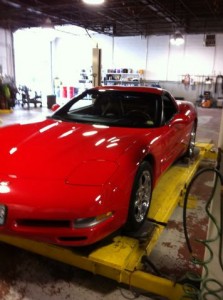Reference: Darty Corvettes
We recently did an alignment on a 2004 Corvette Z06. After we were done, the owner complained that the car was too “darty”; that is, the steering felt like it was over-reacting to changes in the road surface or small inputs from the steering wheel. We will assume a level, although not smooth, road and no cross winds. We will define “darty” as a car’s tendency to change direction without direct input from the driver moving the steering wheel. The car’s alignment was within the factory specifications, front and rear. After research online, we discovered that this is a common complaint from C5 Z06 owners. We re-aligned the car making significant changes, and all settings were again within the factory specifications. The owner said the drivability was much better, and acceptable. The purpose of this article is to explain the causes of this behavior, and how to mitigate those causes.
List of potential causes:
- Alignment
- Bump steer
- Worn components such as tie-rod ends
- Tires (construction, width, and pressure)
Alignment: Too much camber and or too much toe (positive or negative) can cause the car to dart because the temporarily loaded tire (the one going over the raise in the pavement), will temporarily dominate and move the car in the direction of the camber thrust and/or the slip angle of the toe. Why? Because the coefficient of friction of a tire is the load on the tire divided by the lateral force it can withstand (without slipping). Therefore, the tire going over the raise in the pavement temporarily has more of a load on it and it temporarily dominates. If the dominating tire has radical camber or toe, it will track in the direction of those forces.
Bump steer: The car’s front control arm moves up and down as the car travels over uneven road surfaces. If the steering arm does not travel in a parallel arc to the control arm’s arc, the car will be steered to the right or left without any input from the driver.
Worn components: If components such as tie-rod ends, steering boxes or steering racks are worn, and/or have more than 0.050” of play, the car will be darty. On a smooth, flat surface, the normal toe, caster and camber will put a constant pressure on all the steering components which will eliminate the play. However, as soon as one front tire rides over a road imperfection with enough force to over come that pressure, the tire will swing or slap to the other extreme as the play allows.
Tires: The wider the tire the more the tendency for the car to be darty, all other things being constant. Assume a tire is driving down the center of a trough in the road, a truck trough for example, which is a little wider than the tire. As the tire approaches the left edge of the trough, the tire will be drawn, that is pulled, to the left. Why? As the load on the tire is concentrated on the left edge of the tire, the coefficient of friction is increased on the left edge, drawing the tire in that direction. Another contributing factor is the stiffness of the side wall of the tire. The stiffer the side wall the faster the load increases on the outside edges, per the tire in the above example. This is a noticeable trait of some Run Flats (e.g., EMT) tires, and why many drivers notice a significantly better ride when switching from EMT Run Flats to tires like the Michelin Pilot (non Run Flat). Obviously, Run Flats would not be an issue on Z06 Corvettes, but may be an issue on vehicles so equipped.
Getting back to the case in point, we eliminated the bump steer, the car’s ride height had not been changed, and the steering geometry was good as it came from the factory. The components were checked for wear; all were OK. The tires were not Run Flats, but were aged and hardened and due to be changed. So, we reduced the camber and increased the toe-in on the front, as well as raising the pressures in the front by 3psi. Also, we made sure the rear did not have toe out. All were still within factory limits.
Is the non darty alignment the best alignment for all conditions? No, but it’s great for driver comfort and tire wear. It is not the best for an autocross or track day event. When aligning for this type of problem, be sure the tire pressures are set to the manufacturer’s suggested pressures, and that car is ballasted for driver, passengers, and/or fuel, as we do for all of our alignments.






